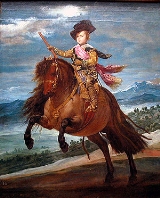
Equestrian Portrait of Prince Balthasar Charles
Encyclopedia
The Equestrian Portrait of Prince Balthasar Charles is a 1635 equestrian portrait
of Balthasar Charles, Prince of Asturias by Diego Velázquez. It is now in the Prado.
Velázquez had been commissioned to paint a series of equestrian portraits meant for the Salón de Reinos
at the palacio del Buen Retiro in Madrid, with this work meant to fill the gap between the two larger equestrian portraits of Balthasar's parents Philip IV
and Elisabeth of France
. The most successful of the series were those of Balthasar and Philip IV.
According to art historian Andrew Graham Dixon: " As court painter to Philip IV of Spain
it was Velázquez's job to create convincing likenesses of the Royal family; to create, in effect, propaganda for the Hapsburg Monarchy, and that's what he was doing when he painted this portrait. The iconography is straightforward. The horse represents the state , upon which the ruler sits holding the reins of power. But Spain in the 1630s/1640s was in perpetual crisis and there is some sense of this fragile hold on power - this little boy on this plump horse, underneath a lowering sky full of dark clouds. The child looks lost."
Portrait
thumb|250px|right|Portrait of [[Thomas Jefferson]] by [[Rembrandt Peale]], 1805. [[New-York Historical Society]].A portrait is a painting, photograph, sculpture, or other artistic representation of a person, in which the face and its expression is predominant. The intent is to display the likeness,...
of Balthasar Charles, Prince of Asturias by Diego Velázquez. It is now in the Prado.
Velázquez had been commissioned to paint a series of equestrian portraits meant for the Salón de Reinos
Salón de Reinos
The Salón de Reinos or salón grande is a wing of the palacio del Buen Retiro in Madrid. Built between 1630 and 1635, it housed the largest paintings in the royal collection, now all in the Museo Nacional del Prado...
at the palacio del Buen Retiro in Madrid, with this work meant to fill the gap between the two larger equestrian portraits of Balthasar's parents Philip IV
Equestrian Portrait of Philip IV
The Equestrian Portrait of Philip IV was a portrait of Philip IV of Spain on horseback, painted by Velázquez in 1635-36 as part of a series of equestrian portraits for the Salón de Reinos at the palacio del Buen Retiro in Madrid ....
and Elisabeth of France
Equestrian Portrait of Elisabeth of France
The portrait Equestrian Portrait of Elisabeth of France was painted by Velázquez of Elisabeth of France between 1628 and 1636, originally for the Salón de Reinos and now in the Prado since the gallery's institution in 1819.-History of the work:...
. The most successful of the series were those of Balthasar and Philip IV.
According to art historian Andrew Graham Dixon: " As court painter to Philip IV of Spain
Philip IV of Spain
Philip IV was King of Spain between 1621 and 1665, sovereign of the Spanish Netherlands, and King of Portugal until 1640...
it was Velázquez's job to create convincing likenesses of the Royal family; to create, in effect, propaganda for the Hapsburg Monarchy, and that's what he was doing when he painted this portrait. The iconography is straightforward. The horse represents the state , upon which the ruler sits holding the reins of power. But Spain in the 1630s/1640s was in perpetual crisis and there is some sense of this fragile hold on power - this little boy on this plump horse, underneath a lowering sky full of dark clouds. The child looks lost."

